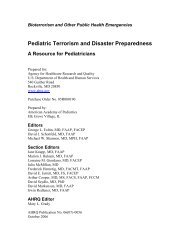(HPP) Performance Measure Manual
(HPP) Performance Measure Manual
(HPP) Performance Measure Manual
You also want an ePaper? Increase the reach of your titles
YUMPU automatically turns print PDFs into web optimized ePapers that Google loves.
INTRODUCTION<br />
Working in close collaboration with internal and external subject matter experts (SMEs), ASPR awardees,<br />
national partner organizations and Federal partners such as the CDC Division of State and Local Readiness<br />
(DSLR) in CDC’s Office of Public Health Preparedness and Response (OPHPR), HSEB has developed a set of<br />
new performance measures for FY12 that enable ASPR and its <strong>HPP</strong> awardees to:<br />
• Enhance situational awareness by assessing healthcare service delivery system capacity and<br />
operational capabilities throughout the nation.<br />
• Provide technical assistance and other training to support awardee needs by identifying gaps and<br />
providing the appropriate support to mitigate challenges.<br />
• Support program improvement and inform policy by translating analytical findings into<br />
information that decision-makers need to make course corrections, as needed. Through evidence<br />
based decision-making, levers for program improvement may be identified.<br />
• Increase transparency by the dissemination of program progress and achievements through<br />
reports, publications, and presentations. The National Health Security Strategy (NHSS)<br />
emphasizes that “more attention should be given to systematic quality improvement methods to<br />
extract and disseminate ‘lessons learned’.”<br />
• Promote sound stewardship of Federal tax dollars by using the data to assess impact of public<br />
funding and ensure that the American taxpayer sees a return on his or her investment. The<br />
development of program measures and continuous quality improvement enables HSEB to critically<br />
evaluate the ability of the <strong>HPP</strong> program to perform its intended goals.<br />
Introduction<br />
Primer on Evaluation<br />
This section is intended to provide readers with a basic understanding of evaluation concepts in order to<br />
lay the foundation for effective performance measurement.<br />
What is evaluation?<br />
Evaluation can be thought of — in simple terms — as collecting, analyzing and ultimately using data to<br />
make decisions. 2 Program evaluation entails collecting and analyzing data to make decisions about a<br />
program or aspects of a program. Ideally, data are collected and analyzed systematically to determine<br />
how well a program is working and why (or why not). 3<br />
There are many types of program evaluation, which can be conducted for a variety of purposes as shown<br />
in Table 4. Two of the more common types on which this guidance focuses include process evaluation<br />
and outcome evaluation. Process evaluations determine whether, and how well, program activities were<br />
implemented. Outcome evaluations, on the other hand, determine whether desired program results<br />
were achieved and the extent to which program activities contributed to these results.<br />
2 Patton, M.Q. (1982). Practical Evaluation. London: Sage Publications.<br />
3 Government Accountability Office. (January 31, 2012). Designing Evaluations 2012 Revision. Accessible at http://www gao.gov/assets/590/588146.pdf<br />
Hospital Preparedness Program (<strong>HPP</strong>) <strong>Performance</strong> <strong>Measure</strong> <strong>Manual</strong><br />
Guidance for Using the New <strong>HPP</strong> <strong>Performance</strong> <strong>Measure</strong>s Page | 3
















